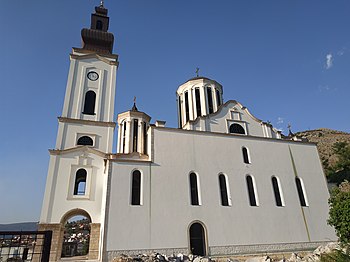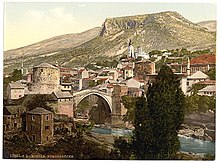Eparchy of Zahumlje and Herzegovina
 From Wikipedia - Reading time: 10 min
From Wikipedia - Reading time: 10 min
Eparchy of Zahumlje and Herzegovina | |
|---|---|
 | |
| Location | |
| Territory | Parts of Bosnia and Herzegovina, Croatia and Montenegro |
| Headquarters | Mostar, Bosnia and Herzegovina[1][2] |
| Information | |
| Sui iuris church | Serbian Orthodox Church (Eastern Orthodox) |
| Established | 1219 (as Eparchy of Hum) |
| Cathedral | Cathedral of the Holy Trinity, Mostar, Bosnia and Herzegovina |
| Language | Church Slavonic and Serbian |
| Current leadership | |
| Bishop | Dimitrije (Rađenović) |
| Map | |
 | |
| Website | |
| Eparchy of Zahumlje and Herzegovina | |
The Eparchy of Zahumlje, Herzegovina and the Littoral (Serbian: Епархија захумско-херцеговачка и приморска, romanized: Eparhija zahumsko-hercegovačka i primorska) is an eparchy (diocese) of the Serbian Orthodox Church with its seat in Mostar, Bosnia and Herzegovina. It has jurisdiction over the region of Herzegovina, the littoral region of southern Dalmatia in Croatia and a small part of Montenegro.[3] Since 2018, the bishop of Zahumlje and Herzegovina has been Dimitrije Rađenović.


History
[edit]Ecclesiastical background
[edit]The region was under the Eastern Orthodox Metropolitanate of Dyrrachium, which in turn was under the Ecumenical Patriarchate of Constantinople or the Archbishopric of Bar.[when?] In 1089, the see of Trebinje (Travunia) was briefly theoretically under the jurisdiction of the Archbishopric of Bar. The territory was constantly in a feudal state of continuous religious wars between the Roman Catholic and Eastern Orthodox denominations long before the incursion of Islamic invaders.
Middle Ages
[edit]The Eparchy of Hum or Zahumlje was founded in 1219, by the first Serbian Archbishop Sava, the same year the Serbian Orthodox Church acquired its autocephaly status from the Patriarchate of Constantinople.[4] Thus, it was one of the original Serbian Orthodox bishoprics. It had jurisdiction over the historical regions of Zahumlje and Travunija. The first Bishop of Hum was Ilarion, succeeded by Sava II (son of Stefan the First-Crowned).[4] The original seat was in Ston, in the church of the Most Holy Theotokos (Пресвете Богородице). Following an earthquake, the bishop moved the seat to the Monastery of Holy Apostles in the valley of river Lim in the 1250s. From that time, the Eparchy of Hum was sometimes also called "Eparchy of Lim".[4]
With the War of Hum (1326–1329), most of Zahumlje was taken over by Stephen II, Ban of Bosnia, but the Travunija region remained under the rule of Serbian Kings. After the creation of the Serbian Patriarchate of Peć in 1346, all original Serbian bishops were raised to the honorary rank of metropolitan bishops. The see of the eparchy was then moved to the Mileševa monastery.[5] In the middle of 15th century, Metropolitan David was a very influential figure in the court of Stefan Kosača, who was titled Duke (Herzeg) of Saint Sava. Following the fall of the Duchy of St. Sava to the Ottoman Empire (1482), the see was frequently moved, finally to settle in the Tvrdoš Monastery near Trebinje in 1508.[4] Eventually, the eparchy was further divided into the Eparchy of Mileševa.
Modern and contemporary history
[edit]In 1557, the Serbian Patriarchate of Peć was restored and the Eparchy of Herzegovina was returned to its jurisdiction, with its bishops holding the honorary title of metropolitan.[6] In 1766, when the Serbian Patriarchate of Peć was abolished, the Eparchy of Herzegovina and all other Serbian eparchies under Ottoman rule came under the jurisdiction of Ecumenical Patriarchate of Constantinople.[7] Bishops of Herzegovina kept their honorary title of Metropolitan, as was also the custom in the Ecumenical Patriarchate.

The seat of metropolitan was transferred to Mostar. In 1878, the territory of Bosnia and Herzegovina was under the occupation of Austria-Hungary, but under the Church Convention of 1880, all Eastern Orthodox eparchies remained under the ecclesiastical jurisdiction of the Ecumenical Patriarchate of Constantinople.[8] An arrangement was made whereby the patriarch held jurisdiction over the Eastern Orthodox churches in Bosnia and Herzegovina, while Vienna was allowed to nominate its bishops, with the patriarch in Constantinople paying an annual fee.[8]
At the end of the First World War in 1918, Eastern Orthodox bishops in Bosnia and Herzegovina reached a unanimous decision to enter the united Serbian Orthodox Church. The process of unification was completed in 1920 and since then the Eparchy of Zahumlje and Herzegovina has remained part of the Serbian Orthodox Church.[9] The seat of the eparchy was the Cathedral of the Holy Trinity, Mostar.[10] As of 2022, it is being rebuilt after being demolished during the Bosnian War (1992–1995).[11]
After the restoration of the Serbian Orthodox Church (1920), and with the Church Constitution (1931), the diocese comprised the districts Mostar, Bileća, Gacko, nevesinje, Stolac, and Trebinje, the towns of Metković and Dubrovnik and the island of Korčula, the birthplace of Marco Polo. The districts of Foča and Čajniče were allotted to the Diocese of Dabar-Bosnia.[12] Since the Serbian Orthodox Church integration of 1920, the bishops of Zahumlje and Herzegovina were Jovan Ilić (1926-1931), Simon Stanković (1932-1934), Tihon Radovanović (1934-1939), Nikolaj Jovanović (1940-1943), Longin Tomić (1951-1955) and Vladislav Mitrović (1955-1991).[12]
During World War II from 1941 to 1943 on the territory of the Eparchy of Zahumlje and Herzegovina, a large number of churches were damaged or destroyed, along with parish homes, libraries and church archives.[13]
At the meeting of the Holy Synod of the Serbian Orthodox Church in 1992, Dr. Atanasije Jevtić was elected for the Bishop of the Eparchy of Zahumlje and Herzegovina.[12]
During the breakup of Yugoslavia and the ensuing Yugoslav wars, the Eparchy of Zahumlje and Herzegovina of all the Serbian Orthodox eparchies sustained the most damage.[14] Twenty-four (24) churches were destroyed and 16 churches were heavily damaged, in addition to the monastery of Zavala. Ten cemeteries were either destroyed or desecrated.
In Mostar, where the see of Zahumlje and Herzegovina was located, everything belonging to the Serbian Orthodox Church was destroyed. The Cathedral of the Holy Trinity, constructed in 1873 at a time of occupation, between 7 and 8 June 1992, was shelled, and on 15 June (on the second day of the Pentecost) the belltowers were destroyed and the cathedral was set ablaze. Subsequently, the remaining walls were mined, and the monumental shrine was turned into rubble.
The old church built in the 16th century in honor of the Birth of the Virgin Mary, situated in the cemetery of Mostar, was also destroyed. The Bishop's Palace, built in the 19th century, was mined while the monastery of Zitomislic which suffered damages in World War II, also met the same fate during the Bosnian war.
Heads
[edit]- Ilarion (13th century)
- Metodije (13th century)
- Teodosije (13th century)
- Nikola (13th century)
- Sava (until 1264)
- Jevstatije (ca. 1305)
- Jovan I (ca. 1316)
- Danilo (1316–1324)
- Stefan I (1324)
- Mileševa (ca. 1377)
- David (ca. 1465)
- Jovan II (1508–1513)
- Visarion I (1509–1525)
- Maksim I (before 1532)
- Marko (1531–1534)
- Nikanor (1534–1546)
- Antonije (1570–1573)
- Savatije I (1573–1585)
- Visarion II (1590–1602)
- Silvestar (1602–1611)
- Simeon I (1613–1635)
- Savatije II (1635–1642)
- Maksim II (1643–1648)
- Pajsije (1648–1651)
- Arsenije I (1651)
- Vasilije (1651–1671)
- Simeon II (1671–1681)
- Savatije III (1681–1693)
- Nektarije (1693–1712)
- Melentije (1712–1713)
- Arsenije II (1715)
- Gerasim (1715–1727)
- Aksentije I (1727–1736)
- Filotej (1741–1741)
- Aksentije II (1751–1760)
- Stefan II (1763–1766)
- Antim (1766–1772)
- Likanije (1772–1802)
- Jeremija (1803–1815)
- Josif I (1816–1835)
- Prokopije I (1838–1848)
- Josif II (1848–1854)
- Grigorije I (1855–1860)
- Joanikije (1860–1864)
- Prokopije II (1864–1875)
- Ignjatije (1875–1888)
- Leontije (1888)
- Serafim (1889–1903)
- Petar (1903–1920)
- Jovan III Ilić (1926–1931)
- Simeon III Stanković (1932–1934)
- Tihon Radovanović (1934–1939)
- Nikolaj Jovanović (1939–1943)
- Longin Tomić (1951–1955)
- Vladislav Mitrović (1955–1991)
- Atanasije (1992–1999)
- Grigorije II (1999–2018)
- Dimitrije (2018–)
Monasteries
[edit]

There are eight monasteries in the diocese:
- Dobrićevo
- Duži
- Žitomislić
- Zavala
- Zubci
- Petropavlov
- Tvrdoš
- Hercegovačka Gračanica
See also
[edit]- Eastern Orthodoxy in Bosnia and Herzegovina
- Serbs of Bosnia and Herzegovina
- List of the Eparchies of the Serbian Orthodox Church
- Cathedral of the Holy Trinity, Mostar
- Holy Annunciation Orthodox church, Dubrovnik
References
[edit]- ^ Blic online: Posle 18 godina Mostar ponovo sedište zahumske eparhije ("Mostar seat of the Diocese of Zahumlje again after 18 years"), 02 Jan 2011 (in Serbian)
- ^ Vesti online: Eparhija zahumsko-hercegovačka posle 20 godina u Mostaru ("Eparchy of Zahumlje and Herzegovina in Mostar after 20 years"), 31 Dec 2010 (in Serbian)
- ^ Official SPC site: Eparchies Links Archived 2021-07-24 at the Wayback Machine (in Serbian)
- ^ a b c d Mileusnić 1997, p. 131.
- ^ Serbian Orthodox Church (1972). Serbian Orthodox Church: Its Past and Present, Volume 3. Serbian Patriarchy. p. 53.
- ^ Sotirović 2011, pp. 143–169.
- ^ Louth, Andrew, ed. (2022). The OxfordDictionary of the Christian Church. Oxford University Press. ISBN 9780192638151.
.. and from 1557 the eparchy of Dabar-Bosnia became part of the restored Serbian patriarchate of Peć.. From 1766, when this patriarchate was suppressed by the Ottomans, the eparchy of Dabar-Bosnia fell under the jurisdiction of the oecumenical patriarch in Constantinipole..
- ^ a b Čuvalo 2010, p. 177.
- ^ Kiminas 2009, pp. 22, 28.
- ^ "Bosnian Orthodox church built on Ottoman land symbolizes peace, unity". Daily Sabbah. 20 January 2021.
- ^ Brezar, Aleksandar (7 January 2022). "Orthodox Christmas: In Mostar, reconstruction of an Orthodox church is a sign of unity". euronews.
- ^ a b c Mileusnić 1997, p. 134.
- ^ Mileusnić 1997, p. 246.
- ^ Documents de séance. Council of Europe. 1994. pp. 30–31. ISBN 9789287124791.
Sources
[edit]- Čuvalo, Ante (2010). The A to Z of Bosnia and Herzegovina. Rowman & Littlefield. ISBN 978-0-81087-647-7.
- Kiminas, Demetrius (2009). The Ecumenical Patriarchate: A History of Its Metropolitanates with Annotated Hierarch Catalogs. Wildside Press LLC. ISBN 9781434458766.
- Mileusnić, Slobodan (1997). Spiritual Genocide: A survey of destroyed, damaged and desecrated churches, monasteries and other church buildings during the war 1991–1995 (1997). Belgrade: Museum of the Serbian Orthodox Church.
- Sotirović, Vladislav B. (2011). "The Serbian Patriarchate of Peć in the Ottoman Empire: The First Phase (1557–94)". Serbian Studies: Journal of the North American Society for Serbian Studies. 25 (2): 143–169. doi:10.1353/ser.2011.0038. S2CID 143629322.
Further reading
[edit]- Јанковић, Марија (1985). Епископије и митрополије Српске цркве у средњем веку (Bishoprics and Metropolitanates of Serbian Church in Middle Ages). Београд: Историјски институт САНУ.
- Boris Nilević (1990). Srpska pravoslavna crkva u Bosni i Hercegovini do obnove Pećke patrijaršije 1557. godine. Veselin Masleša. ISBN 9788621004270.
- Вуковић, Сава (1996). Српски јерарси од деветог до двадесетог века (Serbian Hierarchs from the 9th to the 20th Century). Евро, Унирекс, Каленић.
- Bataković, Dušan T. (1996). The Serbs of Bosnia & Herzegovina: History and Politics. Dialogue Association. ISBN 9782911527104.
- Radić, Radmila (1998). "Serbian Orthodox Church and the War in Bosnia and Herzegovina". Religion and the War in Bosnia. Atlanta: Scholars Press. pp. 160–182. ISBN 9780788504280.
- Popović, Svetlana (2002). "The Serbian Episcopal sees in the thirteenth century (Српска епископска седишта у XIII веку)". Старинар (51: 2001): 171–184.
- Ćirković, Sima (2004). The Serbs. Malden: Blackwell Publishing. ISBN 9781405142915.
External links
[edit]- Eparchy of Zahumlje and Herzegovina (in Serbian)
 KSF
KSF